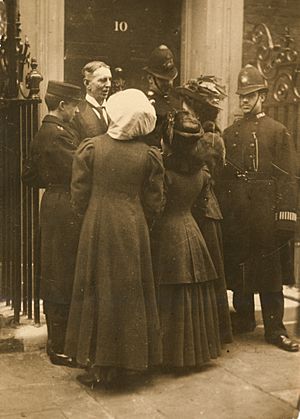Elspeth Douglas McClelland facts for kids

Elspeth Douglas McClelland (1879–1920) was an amazing English woman. She was an activist who fought for women's right to vote, and she was also an architect. She is famous for a time when she became a "human letter" to the Prime Minister!
Her Early Life
Elspeth was born on May 20, 1879, in a town called Keighley in Yorkshire, England. Her parents were John and Epsey McClelland.
She studied to become an architect in London. Imagine this: she was the only female student among 600 men at the Polytechnic Architectural School! Some people even thought she was the first woman to work as an architect. We know she was definitely working as an architect by 1904.
In 1912, Elspeth married William Albert Spencer. They moved to Edgware and had three children. Sadly, Elspeth passed away in 1920 while giving birth. Her family said that the queen gave her a special silver tea set to thank her for helping women's causes.
Fighting for Women's Rights
Elspeth was a suffragette. This means she was part of a group of women who worked very hard to get women the right to vote in elections.
Her most famous moment as a suffragette happened on February 23, 1909. She and another suffragette, Daisy Solomon, decided to become "human letters"! At that time, the Post Office had a rule that allowed people to be sent by special messenger.
So, Elspeth and Daisy were "posted" to the Prime Minister, H. H. Asquith, at 10 Downing Street. They even paid for a threepenny stamp! A messenger boy delivered them right to the Prime Minister's door.
However, an official came out and told them they couldn't be delivered. He said they were "dead letters" and had to be returned! Elspeth and Daisy were sent back to the Women's Social and Political Union office. People said the Prime Minister found the whole thing quite funny. You can even see a photo of this event from the Daily Mirror newspaper on The British Postal Museum & Archive website.
In 1913, Elspeth, who was then Mrs. Elspeth Spencer, put an advertisement in the suffragette newspaper Votes for Women. She advertised herself as an "Architect of uncommon houses and cottages." She also designed furniture and decorations in the suffragette colors!
Designing Homes
Elspeth was a talented architect. While some reports said she was the first woman architect, records show that Ethel Mary Charles became a member of the Royal Institute of British Architects earlier, in 1898.
Even so, Elspeth's work was very important. We can see her designs in old drawings and records. Many of her designs were for homes in Letchworth. One of her most famous designs was for a cottage at 106 Wilbury Road. She designed it for a competition to build a cottage for only £150!
This competition was important because it was hard to build affordable homes in the countryside. Elspeth's design was special because she worked with a group called the Society of Artists. This group was made up of women decorators who felt that architects didn't always think about what women needed in a home.
Elspeth's cottage was named "Elspeth Cottage." It looked like an old English house but was built with modern materials like concrete. She also designed much of the furniture inside.
Elspeth made sure her cottage was practical for the women living there. She said, "Much of the working women's time is spent in the scullery [kitchen area] and I am therefore making it a bright and cheerful room with two windows instead of a dismal back kitchen." She also designed the coal storage and toilet to be accessed from inside the house, with a covered porch, which made life easier for the housewife.
Elspeth gave talks about her cottage design. Newspapers praised her for showing how to build "charming little country cottages" that were comfortable, affordable, and artistic.
She didn't just design houses; she also designed fabrics and furniture to match them. The Daily Express newspaper called her "a young lady of many talents." Another paper, The Lady's Pictorial, said that Elspeth helped open up a new field of work for women. This shows that very few women were working as architects at that time, making Elspeth's work even more special.

